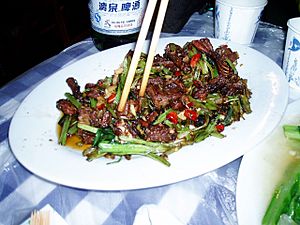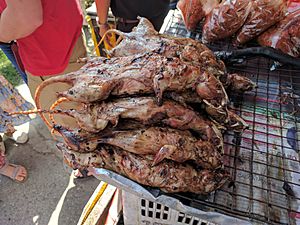Rat meat facts for kids
Rat meat is the meat from different kinds of rats. Rats are medium-sized rodents with long tails.
Even though eating rat meat is considered unusual or even forbidden in some cultures, it is a common food in others. Some people avoid it because they worry about diseases or because of their religious beliefs. However, in many places where rats are common, they have become part of the local diet.
Contents
Rat Meat Around the World
In Africa
In Malawi, a country in East Africa, people hunt field mice in corn fields for food. They often string the mice on sticks and cook, salt, or dry them. These mice are a popular snack sold in markets and by roadsides. In Sub-Saharan Africa, where cane rats live, people often eat them as food.
In the Americas
Rat stew is a special dish from West Virginia in the United States. It became popular when the mining industry there faced problems. This dish is part of what is called "roadkill cuisine" and has even been featured at the Marlington Roadkill Cook-off event.
In Asia

In some cultures, only certain groups of people would eat rats. For example, among the Mishmi people in India, rats are an important part of their traditional diet. Mishmi women traditionally eat only fish, pork, wild birds, and rats. On the other hand, the Musahar community in northern India has started raising rats to sell them as a special food.
Ricefield rat meat is eaten in countries like Vietnam, Taiwan, the Philippines, Cambodia, and China. A dish called Rat-on-a-stick is a roasted rat meal eaten in Vietnam and Cambodia.
A study in 2020 looked at wildlife sold in three southern Vietnamese provinces. It found that more than half of the field rats sold in restaurants carried a type of coronavirus. This shows why it's important to be careful about food safety.
In Europe
In Victorian Britain, both rich and poor people ate rat pie. During World War II, when food was scarce, British scientists were known to eat laboratory rats, sometimes served with cream.
In Valencia, Spain, marsh rat meat was once a main ingredient in traditional paella. This was written about by Vicente Blasco Ibáñez in his book Cañas y barro. Along with eel and local beans, marsh rat was used before being replaced by rabbit, chicken, and seafood in paella.
In South America
In other parts of the world, rat meat is often seen as unclean or socially unacceptable. Some religions, like Islam and Judaism, have rules against eating it. Also, the Shipibo people of Peru and the Sirionó people of Bolivia have cultural rules against eating rats.
In Polynesia
In the old cultures of the Hawaiians and other Polynesians, rats were a common food for everyday people. On Rapa Nui, people could eat rat meat during feasts. However, the king was not allowed to eat it because he was considered sacred, a state called tapu.
Archaeologists studying ancient sites in Hawaii found that common households had three times more rat remains than elite households. The rat bones found were broken, burned, and covered in charcoal, which means the rats were eaten. This suggests that the elite people in ancient Hawaii might not have eaten rats, perhaps because of their social status or taste.
Rats as Pet Food
Rats are a common food for snakes, both in the wild and for pet snakes. For example, adult rat snakes and ball pythons in captivity mostly eat rats. Snake owners, pet shops, and reptile zoos can easily get rats, either alive or frozen, from many suppliers.
In Britain, the Animal Welfare Act 2006 says that prey animals must be killed before being fed to a predator, unless it's absolutely necessary for the predator's health. This rule was put in place mainly because of pressure from groups like the RSPCA, who believed feeding live animals was cruel.
Images for kids




